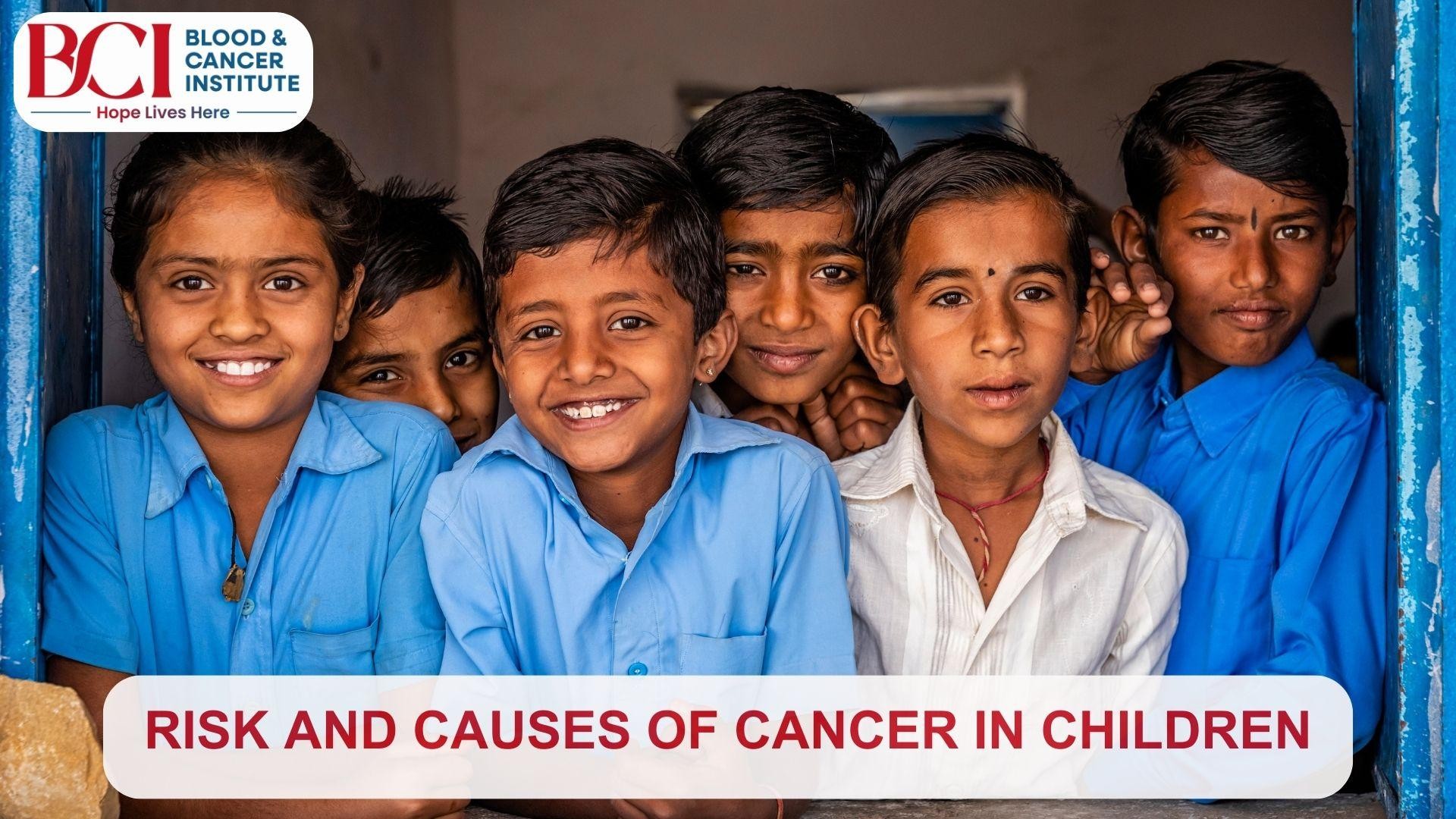
- By : BCI
- General
- Comments: 0
Risks and Causes of Cancer in Children Explained By Cancer Specialist In Surat
Cancer in children is a devastating reality for many families, affecting thousands of young lives every year. Unlike adult cancers, which are often linked to lifestyle and environmental factors, childhood cancers are largely driven by genetic mutations and unknown triggers. This blog will help you in understanding the risks and causes of cancer in children from our experts at BCI- Blood and Cancer Institute, considered as one of the best paediatric cancer specialists in Surat. This aims to raise awareness, promote early detection, and support ongoing research into prevention and treatment.
Understanding Childhood Cancer
Childhood cancers are relatively rare compared to adult cancers, but they remain a leading cause of disease-related death in children. Some of the most common types include:
● Leukemia — The most prevalent childhood cancer, affecting the blood and bone marrow.
● Brain and Central Nervous System (CNS) Tumors — Including gliomas and medulloblastomas.
● Neuroblastoma — A cancer that originates in immature nerve cells, often found in the adrenal glands.
● Wilms Tumor — A kidney cancer primarily affecting young children.
● Lymphoma — Affecting the lymphatic system, including Hodgkin and non-Hodgkin lymphoma.
● Bone Cancers — Such as osteosarcoma and Ewing sarcoma.
According to the cancer specialists in Surat, each type has unique risk factors, but most childhood cancers develop due to genetic changes rather than environmental exposures.
What Causes Cancer in Children?
The exact causes of childhood cancer remain largely unknown. However, researchers have identified several potential genetic, environmental, and medical factors that may contribute to cancer development in children.
1. Genetic Factors and Inherited Mutations
Genetic predisposition plays a crucial role in some childhood cancers. While most cancers in kids are not inherited, some children are born with genetic mutations that increase their risk. These include:
● Li-Fraumeni Syndrome — A mutation in the TP53 gene, which significantly raises the risk of multiple cancers.
● Down Syndrome — Children with Down syndrome have a higher likelihood of developing leukemia.
● Retinoblastoma Gene Mutation (RB1) — Increases the risk of eye cancer (retinoblastoma).
● Neurofibromatosis — A condition that can lead to brain and nerve tumors.
If a family has a history of certain cancers, genetic testing may help identify children at higher risk, says our expert paediatric cancer specialists in Surat .
2. Environmental and Parental Exposures
While lifestyle-related risk factors like smoking or poor diet contribute to adult cancers, environmental exposures can play a role in childhood cancer development. Some potential risk factors include:
● Parental Smoking and Alcohol Use — Some studies suggest that exposure to tobacco or alcohol during pregnancy may slightly increase cancer risks.
● Radiation Exposure — High doses of radiation, whether from medical treatments or environmental sources, can increase the risk of leukemia and brain tumors.
● Pesticides and Chemical Exposure — Some studies suggest a link between parental exposure to pesticides, benzene, or industrial chemicals and childhood cancer.
● Air Pollution — Prolonged exposure to high levels of pollution may have a role in certain cancers, though more research is needed.
3. Immune System Disorders and Medical Treatments
A weakened immune system can leave children more vulnerable to developing cancer. Some key risk factors include:
● Congenital Immune Deficiencies — Conditions like Wiskott-Aldrich syndrome can increase the likelihood of leukemia and lymphoma.
● Prior Cancer Treatments (Secondary Cancers) — Children who have undergone chemotherapy or radiation therapy for another cancer may develop secondary cancers later in life.
● Organ Transplant Recipients — Children who receive organ transplants and take immunosuppressive drugs are at a higher risk of developing lymphoma.
Can Childhood Cancer Be Prevented?
Unlike many adult cancers, which can be prevented through lifestyle choices like quitting smoking or eating a healthy diet, most childhood cancers cannot be prevented because they are caused by random genetic mutations. However, families can take steps to reduce potential environmental risks:
● Avoid exposure to tobacco smoke and harmful chemicals during pregnancy.
● Limit unnecessary radiation exposure from medical imaging.
● Encourage a healthy lifestyle to support overall well-being and immune function.
Signs and Symptoms of Childhood Cancer
Early detection from the best cancer hospital in Surat is crucial for improving survival rates. While symptoms vary depending on the type of cancer, some general warning signs include:
● Unexplained weight loss
● Persistent fever or night sweats
● Frequent infections
● Lumps or swelling in unusual places
● Paleness, bruising, or bleeding
● Persistent bone pain or limping
● Severe headaches, vomiting, or vision changes
If a child experiences persistent or unusual symptoms, parents should seek medical attention promptly, suggest our cancer specialist in Surat.
Ongoing Research and Hope for the Future
Significant advancements have been made in childhood cancer treatment, with survival rates improving dramatically over the past few decades. Current research efforts focus on:
● Personalized Medicine — Targeted therapies based on a child’s specific genetic makeup.
● Immunotherapy — Boosting the immune system to fight cancer more effectively.
● Less Toxic Treatments — Reducing the long-term side effects of chemotherapy and radiation.
Conclusion
While childhood cancer remains a difficult and heartbreaking challenge, understanding its risks and causes is essential for early detection, research, and improved cancer treatment in Surat. Although most childhood cancers cannot be prevented, continued scientific advancements offer hope for better survival rates and less invasive therapies. Raising awareness and supporting childhood cancer research can make a lasting impact on young lives and their families.
